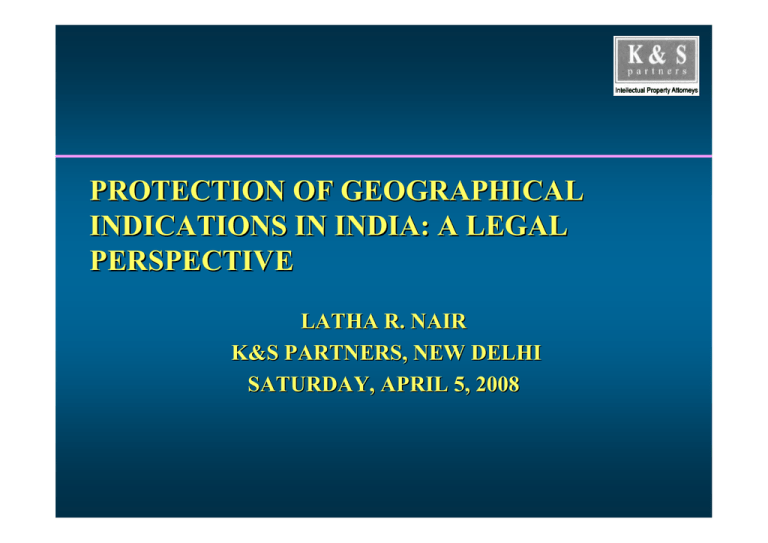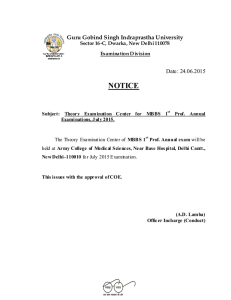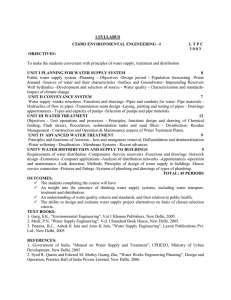PROTECTION OF GEOGRAPHICAL INDICATIONS IN INDIA: A LEGAL PERSPECTIVE LATHA R. NAIR
advertisement

PROTECTION OF GEOGRAPHICAL INDICATIONS IN INDIA: A LEGAL PERSPECTIVE LATHA R. NAIR K&S PARTNERS, NEW DELHI SATURDAY, APRIL 5, 2008 SCOPE • VARIOUS INTELLECTUAL PROPERTY RIGHTS DISTINGUISHED • LEGAL ANGLE • COMMERCIAL ANGLE • DARJEELING: A CASE STUDY • WHAT CAN YOU DO TO PROTECT YOUR GI? © 2008 K&S Partners New Delhi VARIOUS FORMS OF IP RIGHTS DISTINGUISHED • Various IP Rights distinguished – Intellectual Property Rights include rights in Trademark, Copyrights, Patents, Designs and Geographical Indications – Often we read in the press: • ‘Darjeeling has been patented’ • ‘Chanderi Saris get geographical indication patent’ • ‘Alphonso to be trademarked’ – All these expressions clearly indicate the prevailing confusion among the media, general public and even lawyers regarding IP concepts © 2008 K&S Partners New Delhi VARIOUS FORMS OF IP RIGHTS DISTINGUISHED – It, therefore becomes essential to distinguish the various IP rights as follows: • Trademarks – Rights granted to proprietors in respect of signs / marks that distinguish the source of one product from another. • Patents – Rights granted for a specific period for a novel and industrially useful invention. • Designs – Rights granted to the ornamental, aesthetic and non-functional features of a product. © 2008 K&S Partners New Delhi VARIOUS FORMS OF IP RIGHTS DISTINGUISHED • Copyrights – Rights granted to authors for original literary, dramatic, artistic and musical works. Also covers broadcasting rights, performer’s rights, rights in mechanical works such as cinematograph films and sound recordings • Geographical indications – Collective community rights held in indications that identify a product as originating in a country or a region thereof whose quality, reputation or other characteristics are attributable to its geographical origin. – Two types of GIs – Geographical names (Darjeeling, Kancheepuram) and non-geographical names (Feni, Basmati, Pashmina, Alphonso) © 2008 K&S Partners New Delhi LEGAL ANGLE • History of legal protection of GIs may be traced back to the following conventions: – – – – PARIS CONVENTION (1883) AS REVISED MADRID AGREEMENT (1891) AS REVISED LISBON AGREEMENT (1958) TRIPS Agreement (1995) • What is relevant to today’s discussions would be the TRIPS Agreement which mandates protection for GIS by all its members including India © 2008 K&S Partners New Delhi LEGAL ANGLE • TRIPS AGREEMENT – Article 22 • Geographical Indication – identifies a product as originating in a country or a region thereof – whose quality, reputation or other characteristic is attributable to its geographical origin – Article 23 • Additional Protection for GIs for wines & spirits – Protection is extended to GIs relating to wines/spirits not originating in the place indicated by the GI in question even where:» true origin of the goods is indicated; or » the GI is used with expressions such as “kind”, “type”, “style”, “imitation” etc. © 2008 K&S Partners New Delhi LEGAL ANGLE Exceptions to protection – Article 24.9 • No protection to GIs which – are not protected in the country of origin – cease to be protected in the country of origin – have fallen into disuse in the country of origin © 2008 K&S Partners New Delhi LEGAL ANGLE • INIDAN LAW ON GIS – Indian law on GIs has been in force in India since September 15, 2003 – It is called the Geographical Indication of Goods (Registration and Protection) Act, 1999 – A GI Registry is located in Chennai and the Registrar of Geographical Indications looks into GI Applications – There are over 40 GIs that have been registered under the Act so far. © 2008 K&S Partners New Delhi LEGAL ANGLE • Some salient features of the Act – Even a non-geographical name is registrable as a GI under the Act. Hence names like Feni, Paschmina, Basmati, Alphonso etc are registrable even though they are not geographical names – Goods registrable as GIs under the Act include agricultural, goods, manufactured goods, natural goods, handicrafts and foodstuffs. – Generic names are not registrable under the Act as GIs – Any association of persons or producers or any organization or statutory authority representing the interests of the producers of the goods may apply to register a GI © 2008 K&S Partners New Delhi LEGAL ANGLE – An application shall contain the following: • A statement as to how the geographical indication serves to designate the goods as originating from the particular region w.r.t its reputation or characteristics • Class of goods to which the GI shall apply • A geographical map of the region where the goods are manufactured or produced • Particulars regarding the appearance of the GI-logo or word • Statement containing the particulars of the producers of the concerned goods © 2008 K&S Partners New Delhi LEGAL ANGLE – Once applied for, a technical committee would be constituted by the examiner and thereafter based on the comments of the Technical Committee, the examiner will issue an office action – Once the office action is satisfactorily responded to, the GI office will cause the application to be advertised for oppositions – Within 3 months of the advertisement any person may oppose the application – If the GI passes through the opposition period unopposed or in the event of opposition it was decided in favour of the applicant, the Registrar shall direct the GI to be registered. – A registered GI is protected against infringement – The Act prohibits the registration of a GI as a trademark – Criminal remedies are provided for under the Act for applying false geographical indications and falsifying a geographical indication © 2008 K&S Partners New Delhi LEGAL ANGLE • What happens when a GI is not protected? – The GI becomes a generic word – Factors causing genericide • Delay - allowing a GI to be used as a generic word to describe the product for a considerable period of time • Acquiescence - failure to restrain use of the GI upon similar/dissimilar products in the country of origin or other regions © 2008 K&S Partners New Delhi LEGAL ANGLE • Illustrative Examples – Indian examples – Kolhapuri slippers – British Sherry case (1969) - the defendant’s use of “British Sherry” for almost 100 years held fatal - the Spaniards lost – Epsom salt - The name of a region famous for its salt springs but became generic word for Sulphate of Magnesia from any other region © 2008 K&S Partners New Delhi LEGAL ANGLE • Some Indian case law on GIs – Dyer Meakin Breweries v. Scotch Whisky Association (AIR 1980 Delhi 125) • Opposition to Application by Dyer Meakin Breweries of the mark “Highland Chief” in respect of a product described as ‘malted whisky’. – Scotch Whisky Association & Anr v. Parvara Sahakar Shakar Karkhana Ltd (AIR 1992 Bom 295) • Passing off action against defendants for using the expression ‘blended with Scotch’ © 2008 K&S Partners New Delhi LEGAL ANGLE – Scotch Whisky Association & Ors v. Golden Bottling Ltd [2006 PTC 656 (Del)] • Use of ‘Red Scot’ found to be violative of the rights of stake holders in the GI “Scotch Whisky” – Srilab Breweries Pvt Ltd v. Scotch Whisky Association [2006 PTC 527 (Reg.)] • The Trade Marks Registrar rejected a mark containing the words, ‘Rare Blend’ on the ground that the said expression is used by the whisky trade including Scotch Whisky to describe their blends. © 2008 K&S Partners New Delhi COMMERCIAL ANGLE • There is a need for building brand equity through promotional campaign in diverse markets • There is a need for documentation of: • Traditional knowledge in the cultivation/ manufacture/ production methods • All advertising and promotional expenditure • From a commercial angle what is most important is to keep the supply chain integrity of the product in tact. This involves couple of aspects: © 2008 K&S Partners New Delhi COMMERCIAL ANGLE – Confine the production to the traditional area of production – The quality and nature of the input of raw materials and processes must be consistent – The production must conform to traditional methods of processing © 2008 K&S Partners New Delhi DARJEELING: A CASE STUDY LEGAL ANGLE DOMESTIC PROTECTION • Darjeeling word and logo have been registered as CTM (since ’98 and ’86 respectively) in India • Important features of registration: • Can apply only to tea produced in the 87 gardens • Processed in the factories located in the gardens • When tested by tea tasters, it should have the distinctive and naturally occurring organoleptic characteristics of taste, aroma and mouth feel typical of tea cultivated in the said region • Any blend of Darjeeling Tea must contain only teas each of which is a blend of Darjeeling tea grown in any of the 87 gardens © 2008 K&S Partners New Delhi DARJEELING: A CASE STUDY • Darjeeling word and logo have been registered as Geographical Indications under the new GI law that came into effect in September 2003 • These registrations date back to October 2003. • In addition, the Tea Board has also registered the Darjeeling logo as an artistic copyrighted work • Inspection mechanism put in place © 2008 K&S Partners New Delhi DARJEELING: A CASE STUDY INTERNATIONAL PROTECTION • 1997 Benelux Countries (Belgium, Netherlands, Luxembourg) – Collective mark protection for DARJEELING logo • 1998 - World Wide Watch agency CompuMark appointed to monitor conflicting marks. • 2004 Japan – Collective mark application filed for DARJEELING word • 2004 Australia – Certification mark applications for DARJEELING word and logo marks (logo accepted) • 2004 Germany – Collective mark application filed for DARJEELING word © 2008 K&S Partners New Delhi DARJEELING: A CASE STUDY • Pursuant to the watch agency being appointed: • Instances of attempted registrations by third parties found • Some challenged through oppositions & cancellations and sometimes negotiations. • Registrations in over 8 countries so far apart from EU and BENELUX • 1998 – UK - Certification mark protection for DARJEELING word • 2002 USA – Certification mark protection for DARJEELING word © 2008 K&S Partners New Delhi DARJEELING: A CASE STUDY • 2003 – Russia – Trade mark registration for DARJEELING word • 2003 India - GI application filed for DARJEELING word & logo marks, accepted and published in the first GI Journal in July 2004 • 2004 India – Copyright registration obtained for DARJEELING logo © 2008 K&S Partners New Delhi DARJEELING: A CASE STUDY SUCCESSFUL ENFORCEMENTS • Tea Board has currently legal battles going on against third party usurpers in over 15 jurisdictions of the world • Typical strategy used by Tea Board as soon as it receives a watch notice is: • Write to the applicant and try for amicable resolution • If not complying then file an opposition/ cancellation action as the case may be © 2008 K&S Partners New Delhi DARJEELING: A CASE STUDY • The following are some of the notable successful amicable resolutions: • France (1) • Use by applicant of mark ‘Plant Asia Grand Vert Thé Darjeeling’ • Classes 30, 31 & 32. • Tea Board wrote to applicant to withdraw application • It was accordingly withdrawn. © 2008 K&S Partners New Delhi DARJEELING: A CASE STUDY • France (2) • Application by Comptoir Des Parfumes for DARJEELING for perfumes • Tea Board wrote to the applicant • Applicant agreed to limit goods to ‘all those goods being made of Darjeeling tea or recalling the scent of Darjeeling tea’ • Filed for amendment • TMO in France rejected the same on grounds of descriptiveness © 2008 K&S Partners New Delhi DARJEELING: A CASE STUDY • Germany (1) • Registration of domain name www.darjeeling.de by German applicant • C&D issued wherein damages and costs were claimed • Registrant canceled the domain name and signed a declaration • Also paid attorneys costs in full • Germany (2) • German company registering the mark TeaKampagne Darjeeling with Darjeeling logo • Applicant settled matter by allowing mark to lapse © 2008 K&S Partners New Delhi DARJEELING: A CASE STUDY • The following are some decisions favoring Tea Board issued by some national courts: • France • Applicant Dusong adopted the following mark in respect of goods in classes 16, 35 & 41 © 2008 K&S Partners New Delhi DARJEELING: A CASE STUDY • While the Tribunal de Grand Instance rejected Tea Board’s claim, the Court of Appeal Paris upheld the same • The court held that Darjeeling is a GI and the acts of Mr. Dusong were parasitic and amounted to unfair competition • Further, the bad faith adoption was writ large from the fact that he used a tea pot device along with the mark • The court also imposed heavy costs on Mr. Dusong © 2008 K&S Partners New Delhi DARJEELING: A CASE STUDY • USA • DARJEELING v. DARJEELING NOUVEAU • Opposition filed by Tea Board before the Trademark Trial and Appellate Board (TTAB) USA • Based on its US CTM registrations, Tea Board demanded that the mark ‘Darjeeling Nouveau’ by Republic of Tea (ROT) be refused • ROT filed a counterclaim that Tea Board’s CTM registrations be cancelled on alleged grounds of genericness © 2008 K&S Partners New Delhi DARJEELING: A CASE STUDY • While granting Tea Board’s claims, TTAB held that: • Darjeeling is an inherently distinctive certification trademark indicating geographic origin • ROT adduced no evidence to prove claims of genericness and Tea Board had adequate control over the use of the CTM • The test for determining genericness of a mark is its primary significance to the relevant public © 2008 K&S Partners New Delhi DARJEELING: A CASE STUDY COMMERCIAL ANGLE • Commercial angle is as important to GI protection as legal angle • What constitutes commercial angle? • • Projection and promotion of the GI through advertisements Need for building brand equity through promotional campaigns in diverse markets • Tea Board has been: • Conducting Tea Festivals in foreign jurisdictions • Organizing seminars on IPRS and in particular GIs • Issuing advertisements in the national and international media promoting Darjeeling • Creating awareness © 2008 K&S Partners New Delhi © 2008 K&S Partners New Delhi © 2008 K&S Partners New Delhi WHAT CAN YOU DO TO PROTECT FENI? • What is the need of the hour? – Know that Feni is a GI, recognize it and elevate it to such a status – Form an association of producers of Feni and make rules as to how to protect the property and goodwill in Feni – Define and document traditional practices used to produce Feni – Define the geographical boundary where Feni is produced – Form rules and regulations for production of Feni and urge all right holders to adhere to the same – Even if Feni is not registered at the moment, start taking action against any attempts to abuse Feni © 2008 K&S Partners New Delhi WHAT CAN YOU DO TO PROTECT FENI? – Recognize that the following constitute abuse of a GI • Using Feni as a generic word to describe a type of liquor • Allowing the Feni to be spelt as ‘feni’ • Describing liquor that is not Feni in such a manner as to bring in an association with Feni (E.g. ‘Feni’ type of drink) – While making trademark applications to register a trademark used to trade in Feni follow these steps: • restrict the goods to Feni only and not the entire class of goods. • abstain from using the GI Feni along with the mark • If at all used, disclaim any exclusive rights to the GI Feni – Create awareness through ad campaigns and other means to increase the visibility of Feni as a GI – Go ahead and register Feni under the new Indian law © 2008 K&S Partners New Delhi THANK YOU FOR YOUR ATTENTION! © 2008 K&S Partners New Delhi


